Comparative Study on Interface Fracture of 4th Generation 3-Steps Adhesive and 7th Generation Universal Adhesive
Abstract
1. Introduction
2. Materials and Methods
2.1. Specimen Fabrication
2.2. Optic and Electronic Microscopy and Chemical Composition Evaluation
2.3. FEA Simulation of Fracture Behavior
3. Results
3.1. Optic and Electronic Interface Evaluation and Chemical Composition
3.2. FEA Simulation of the Reconstructed Tooth
3.3. FEA Simulation of Crack Propagation
4. Discussions
5. Conclusions
Author Contributions
Funding
Institutional Review Board Statement
Informed Consent Statement
Data Availability Statement
Conflicts of Interest
References
- Handelman, S.L.; Shey, Z. Michael Buonocore and the Eastman Dental Center: A Historic Perspective on Sealants. J. Dent. Res. 1996, 75, 529–534. [Google Scholar] [CrossRef] [PubMed]
- Sofan, E.; Sofan, A.; Palaia, G.; Tenore, G.; Romeo, U.; Migliau, G. Classification review of dental adhesive systems: From the IV generation to the universal type. Ann. Stomatol. 2017, 8, 1–17. [Google Scholar] [CrossRef]
- de Boer, M.; Zimmermann, M.; Attin, T.; Tauböck, T.T.; Hamza, B. Marginal Integrity of Simplified Adhesive Strategies in Primary Teeth. Int. Dent. J. 2023, in press. [Google Scholar] [CrossRef]
- Wang, L.; Zheng, Y. The Impact of Artificial Aging on the Color Stability and Hardness of Nanocomposite Resin. Front. Mater. 2021, 8, 722131. [Google Scholar] [CrossRef]
- Gutiérrez, M.F.; Alegría-Acevedo, L.F.; Núñez, A.; Méndez-Bauer, L.; Ñaupari-Villasante, R.; de Souza, J.J.; Buvinic, S.; Dávila-Sánchez, A.; Fernández, E.; Loguercio, A.D. In vitro biological and adhesive properties of universal adhesive systems on sound and caries-affected dentine: 18 months. Int. J. Adhes. Adhes. 2022, 114, 103107. [Google Scholar] [CrossRef]
- Wendlinger, M.; Pomacóndor-Hernández, C.; Pintado-Palomino, K.; Cochinski, G.; Loguercio, A. Are universal adhesives in etch-and-rinse mode better than old 2-step etch-and-rinse adhesives? One-year evaluation of bonding properties to dentin. J. Dent. 2023, 132, 104481. [Google Scholar] [CrossRef]
- Hurtado, A.; Fuentes, V.; Cura, M.; Tamayo, A.; Ceballos, L. Long-Term In Vitro Adhesive Properties of Two Universal Adhesives to Dentin. Materials 2023, 16, 3458. [Google Scholar] [CrossRef]
- Bisco All-Bond 3. Available online: https://global.bisco.com/all-bond-3-/ (accessed on 21 August 2023).
- Clearfil Universal Bond. Available online: https://www.kuraraynoritake.com/world/product (accessed on 21 August 2023).
- Chesterman, J.; Jowett, A.; Gallacher, A.; Nixon, P. Bulk-fill resin-based composite restorative materials: A review. Br. Dent. J. 2017, 222, 337–344. [Google Scholar] [CrossRef]
- Demarco, F.F.; Corrêa, M.B.; Cenci, M.S.; Moraes, R.R.; Opdam, N.J.M. Longevity of posterior composite restorations: Not only a matter of materials. Dent. Mater. 2012, 28, 87–101. [Google Scholar] [CrossRef]
- Burke, F.J.T. Dental Materials—What goes where? The current status of glass ionomer as a material for load bearing restoration in posterior teeth. Dent. Update 2013, 40, 840–844. [Google Scholar] [CrossRef]
- Gradia Direct. Available online: https://www.gcamerica.com/products (accessed on 21 August 2023).
- Darvell, B.W. Mechanical test relevance—A personal perspective on some methods and requirements. Front. Dent. Med. 2023, 3, 1084006. [Google Scholar] [CrossRef]
- Martinez-Mondragon, M.; Urriolagoitia-Sosa, G.; Romero-Ángeles, B.; Pérez-Partida, J.C.; Cruz-Olivares, I.M.; Urriolagoitia-Calderón, G. Bilinear Numerical Analysis of the Structural Behavior of a Dental Implant Applied as a Biomaterial Carbon Fiber Reinforced Polyether-Ether-Ketone (CFR-PEEK): A Finite Element Analysis. Dent. Hypotheses 2023, 14, 45–48. [Google Scholar]
- Tang, C.-B.; Liu, S.-Y.; Zhou, G.-X.; Yu, J.-H.; Zhang, G.-D.; Bao, Y.-D.; Wang, Q.-J. Nonlinear finite element analysis of three implant–abutment interface designs. Int. J. Oral Sci. 2012, 4, 101–108. [Google Scholar] [CrossRef] [PubMed]
- Tatarciuc, M.; Maftei, G.A.; Vitalariu, A.; Luchian, I.; Martu, I.; Diaconu-Popa, D. Inlay-Retained Dental Bridges—A Finite Element Analysis. Appl. Sci. 2021, 11, 3770. [Google Scholar] [CrossRef]
- Oancea, R.; Bradu, A.; Sinescu, C.; Negru, R.M.; Negrutiu, M.L.; Antoniac, I.; Duma, V.-F.; Podoleanu, A.G. Assessment of the sealant/tooth interface using optical coherence tomography. J. Adhes. Sci. Technol. 2015, 29, 49–58. [Google Scholar] [CrossRef]
- Iulian, A.; Cosmin, S.; Aurora, A. Adhesion aspects in biomaterials and medical devices. J. Adhes. Sci. Technol. 2016, 30, 1711–1715. [Google Scholar] [CrossRef]
- Earar, K.; Antoniac, V.I.; Baciu, S.; Bran, S.; Onisor, F.; Milea, C.; Mohan, A.; Grigoroiu, R.; Saceleanu, A.; Manole, M. Etching Treatment Effect on Surface Morphology of Dental Structures. Rev. Chim. 2017, 68, 2700–2703. [Google Scholar] [CrossRef]
- Pan, Y.; Xu, X.; Sun, F.; Meng, X. Surface morphology and mechanical properties of conventional and self-adhesive resin cements after aqueous aging. J. Appl. Oral Sci. 2018, 27, e20170449. [Google Scholar] [CrossRef]
- Watanabe, H.; Khera, S.C.; Vargas, M.A.; Qian, F. Fracture toughness comparison of six resin composites. Dent. Mater. 2008, 24, 418–425. [Google Scholar] [CrossRef]
- Mese, A.; Palamara, J.E.A.; Bagheri, R.; Fani, M.; Burrow, M.F. Materials and Methods Fracture toughness of seven resin composites evaluated by three methods of mode I fracture toughness (KIc). Dent. Mater. J. 2016, 35, 893–899. [Google Scholar] [CrossRef]
- Howard, K.; Söderholm, K.-J.M. Fracture toughness of two dentin adhesives. Dent. Mater. 2010, 26, 1185–1192. [Google Scholar] [CrossRef] [PubMed]
- Fischer, H.; Marx, R. Fracture toughness of dental ceramics: Comparison of bending and indentation method. Dent. Mater. 2002, 18, 12–19. [Google Scholar] [CrossRef] [PubMed]
- Drummond, J. Degradation, Fatigue, and Failure of Resin Dental Composite Materials. J. Dent. Res. 2008, 87, 710–719. [Google Scholar] [CrossRef]
- Lien, W.; Vandewalle, K.S. Physical properties of a new silorane-based restorative system. Dent. Mater. 2010, 26, 337–344. [Google Scholar] [CrossRef]
- Fani, M.; Farmani, S.; Bagheri, R. Fracture Toughness of Resin Composites under Different Modes and Media: Review of Articles. J. Dent. Biomater. 2015, 2, 73–82. [Google Scholar]
- Trindade, F.Z.; Valandro, L.F.; de Jager, N.; Bottino, M.A.; Kleverlaan, C.J. Elastic Properties of Lithium Disilicate Versus Feldspathic Inlays: Effect on the Bonding by 3D Finite Element Analysis. J. Prosthodont. 2016, 27, 741–747. [Google Scholar] [CrossRef]
- Walls, A.W.G.; Lee, J.; McCabe, J.F. The bonding of composite resin to moist enamel. Br. Dent. J. 2001, 191, 148–150. [Google Scholar] [CrossRef] [PubMed]
- Kimmes, N.S.; Barkmeier, W.W.; Erickson, R.L.; Latta, M.A.; Kimmes, W.W.B.N.S.; Mobarak, E.; Ali, N.; Daifalla, L.; Takamizawa, T.; Tsujimoto, A.; et al. Adhesive Bond Strengths to Enamel and Dentin Using Recommended and Extended Treatment Times. Oper. Dent. 2010, 35, 112–119. [Google Scholar] [CrossRef]
- Yoshihara, K.; Nagaoka, N.; Okihara, T.; Kuroboshi, M.; Hayakawa, S.; Maruo, Y.; Nishigawa, G.; De Munck, J.; Yoshida, Y.; Van Meerbeek, B. Functional monomer impurity affects adhesive performance. Dent. Mater. 2015, 31, 1493–1501. [Google Scholar] [CrossRef]
- Nathanson, D.; Antebi, R.; Hughes, C.V. Bonding Self-Etching Adhesives to Enamel and Dentin In-Vitro; Abstract 2973; IADR: Baltimore, MD, USA, 2005. [Google Scholar]
- Scribante, A.; Bollardi, M.; Chiesa, M.; Poggio, C.; Colombo, M. Flexural Properties and Elastic Modulus of Different Esthetic Restorative Materials: Evaluation after Exposure to Acidic Drink. BioMed Res. Int. 2019, 2019, 5109481. [Google Scholar] [CrossRef]
- Koc, D.; Dogan, A.; Bek, B. Bite Force and Influential Factors on Bite Force Measurements: A Literature Review. Eur. J. Dent. 2010, 4, 223–232. [Google Scholar] [CrossRef] [PubMed]
- Zhao, Y.; Ye, D. Measurement of biting force of normal teeth at different ages. Hua Xi Yi Ke Da Xue Xue Bao 1994, 25, 414–417. [Google Scholar] [PubMed]
- Vieira, M.; Bommarito, S.; Takaki, P. Maximum Bite Force Analysis in Different Age Groups. Int. Arch. Otorhinolaryngol. 2014, 18, 272–276. [Google Scholar] [CrossRef] [PubMed]
- Jin, X.-Z.; Homaei, E.; Matinlinna, J.P.; Tsoi, J.K.H. A new concept and finite-element study on dental bond strength tests. Dent. Mater. 2016, 32, e238–e250. [Google Scholar] [CrossRef] [PubMed]
- Misra, A.; Spencer, P.; Marangos, O.; Wang, Y.; Katz, J.L. Micromechanical analysis of dentin/adhesive interface by the finite element method. J. Biomed. Mater. Res. 2004, 70, 56–65. [Google Scholar] [CrossRef]
- Linul, E.; Marsavina, L.; Stoia, D.I. Mode I and II fracture toughness investigation of Laser-Sintered Polyamide. Theor. Appl. Fract. Mech. 2020, 106, 102497. [Google Scholar] [CrossRef]
- Stoia, D.I.; Linul, E.; Marsavina, L. Mixed-mode I/II fracture properties of selectively laser sintered polyamide. Theor. Appl. Fract. Mech. 2022, 121, 103527. [Google Scholar] [CrossRef]
- Jang, J.-H.; Lee, M.G.; Woo, S.U.; Lee, C.O.; Yi, J.-K.; Kim, D.-S. Comparative study of the dentin bond strength of a new universal adhesive. Dent. Mater. J. 2016, 35, 606–612. [Google Scholar] [CrossRef]
- Chowdhury, A.F.M.A.; Alam, A.; Yamauti, M.; Lloret, P.; Saikaew, P.; Carvalho, R.M.; Sano, H. Characterization of an Experimental Two-Step Self-Etch Adhesive’s Bonding Performance and Resin-Dentin Interfacial Properties. Polymers 2021, 13, 1009. [Google Scholar] [CrossRef]
- Kasahara, Y.; Takamizawa, T.; Hirokane, E.; Tsujimoto, A.; Ishii, R.; Barkmeier, W.W.; Latta, M.A.; Miyazaki, M. Comparison of different etch-and-rinse adhesive systems based on shear fatigue dentin bond strength and morphological features the interface. Dent. Mater. 2021, 37, e109–e117. [Google Scholar] [CrossRef]
- Kanniappan, G.; Hari, P.; Jujare, R.H. Comparative Evaluation of Resin Dentin Interface using Universal and Total- Etch Adhesive Systems on Sound and Eroded Dentin: In Vitro Study. Eur. J. Dent. 2021, 16, 153–160. [Google Scholar] [CrossRef]
- Sato, T.; Takagaki, T.; Hatayama, T.; Nikaido, T.; Tagami, J. Update on Enamel Bonding Strategies. Front. Dent. Med. 2021, 2, 666379. [Google Scholar] [CrossRef]
- Sismanoglu, S.; Yildirim-Bilmez, Z.; Gurcan, A.T.; Gumustas, B. Influence of application mode of universal adhesive on the surface morphology, elemental composition and bond strength of calcium silicate-based cements to composite resin: A SEM-EDX microanalysis study. J. Adhes. Sci. Technol. 2022, 36, 1833–1846. [Google Scholar] [CrossRef]
- Meng, Y.; Huang, F.; Wang, S.; Li, M.; Lu, Y.; Pei, D.; Li, A. Bonding Performance of Universal Adhesives Applied to Nano-Hydroxyapatite Desensitized Dentin Using Etch-and-Rinse or Self-Etch Mode. Materials 2021, 14, 4746. [Google Scholar] [CrossRef]
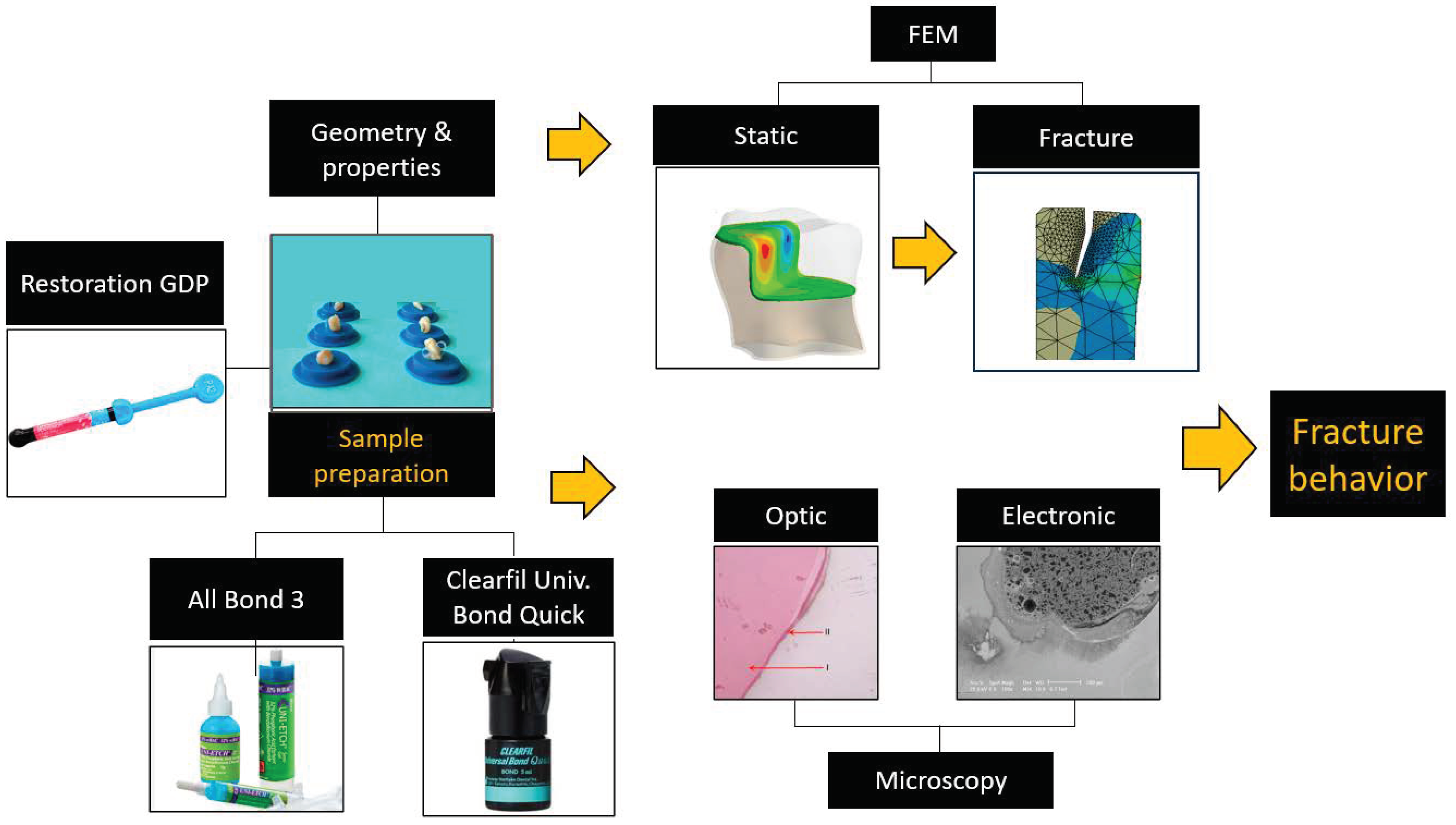


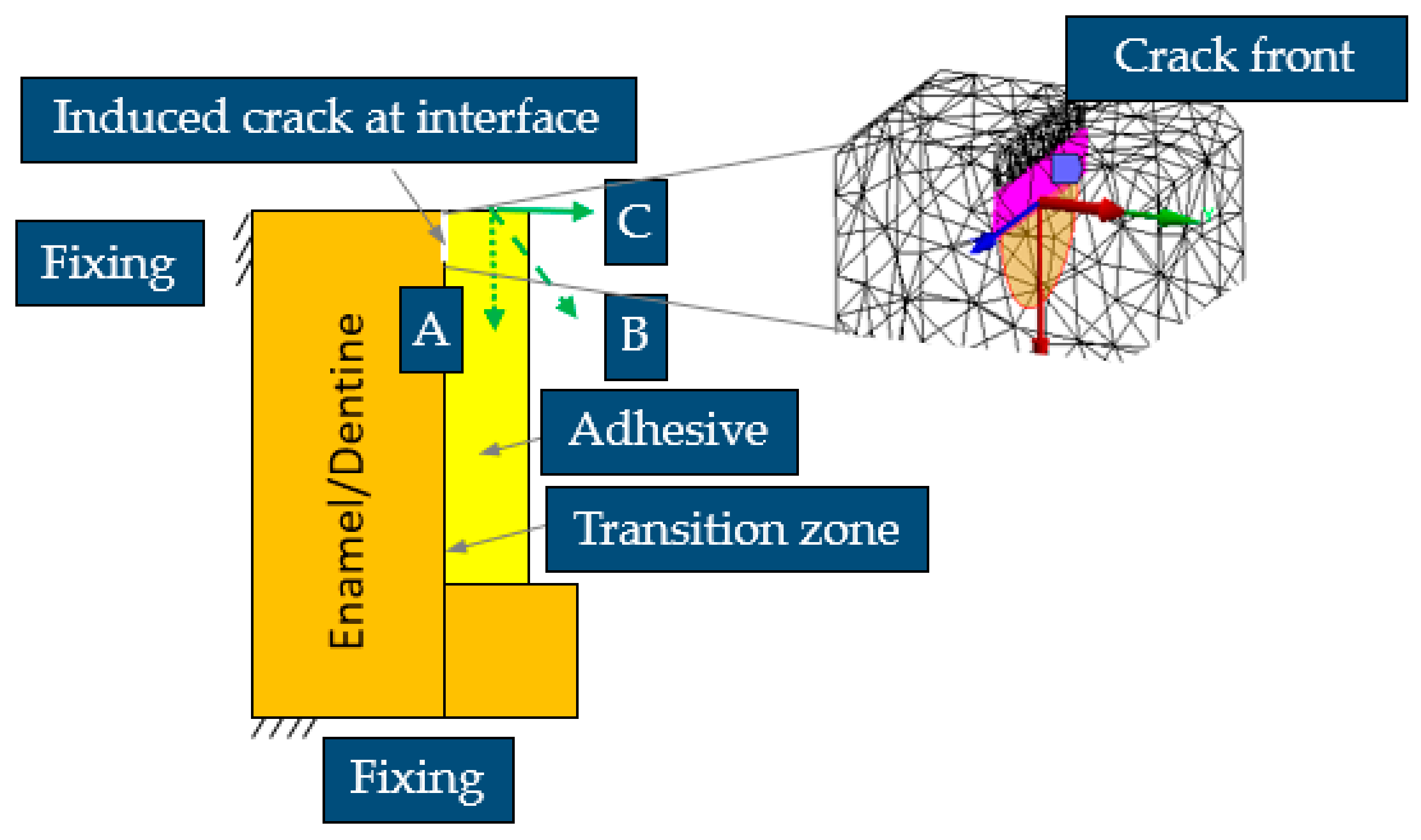

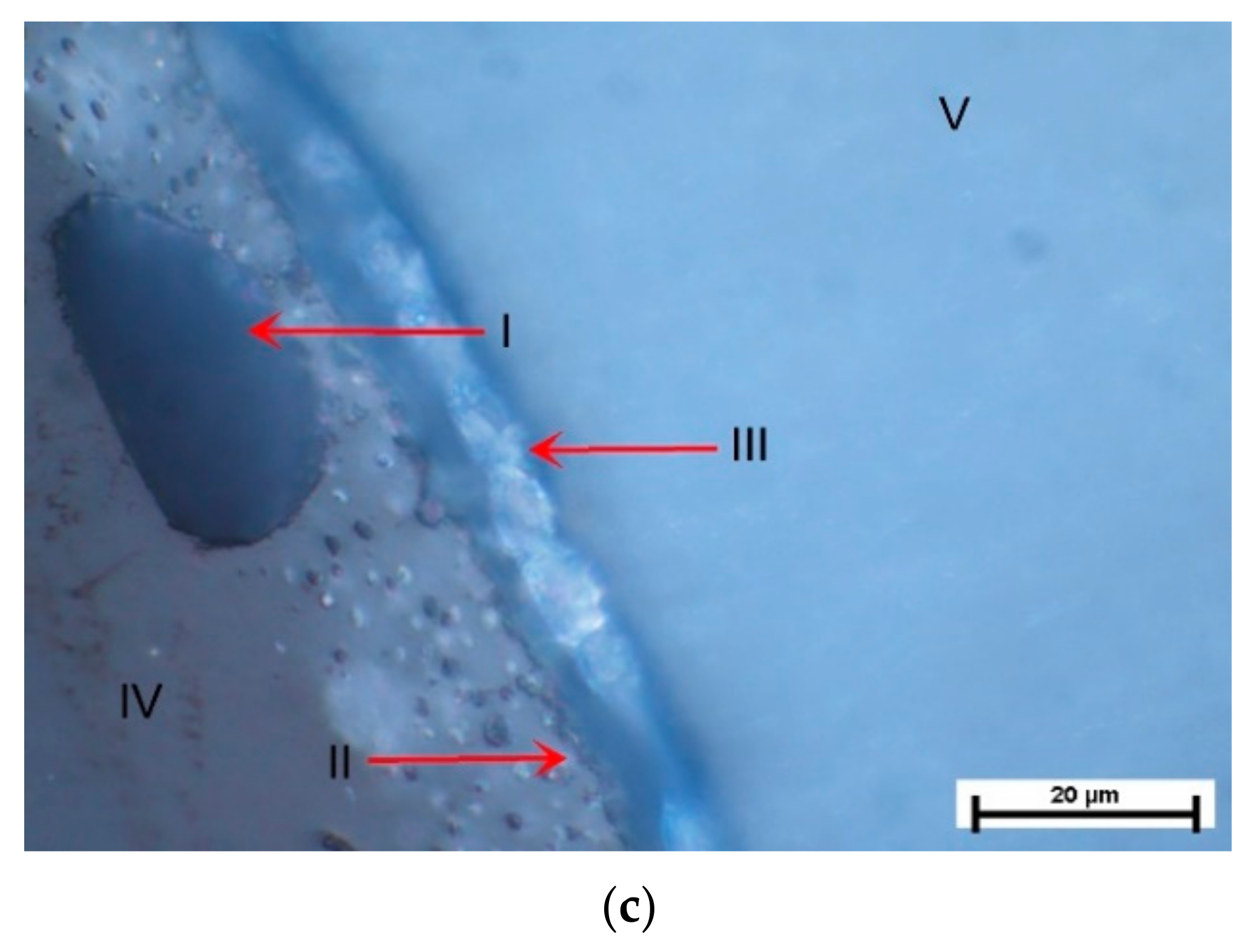




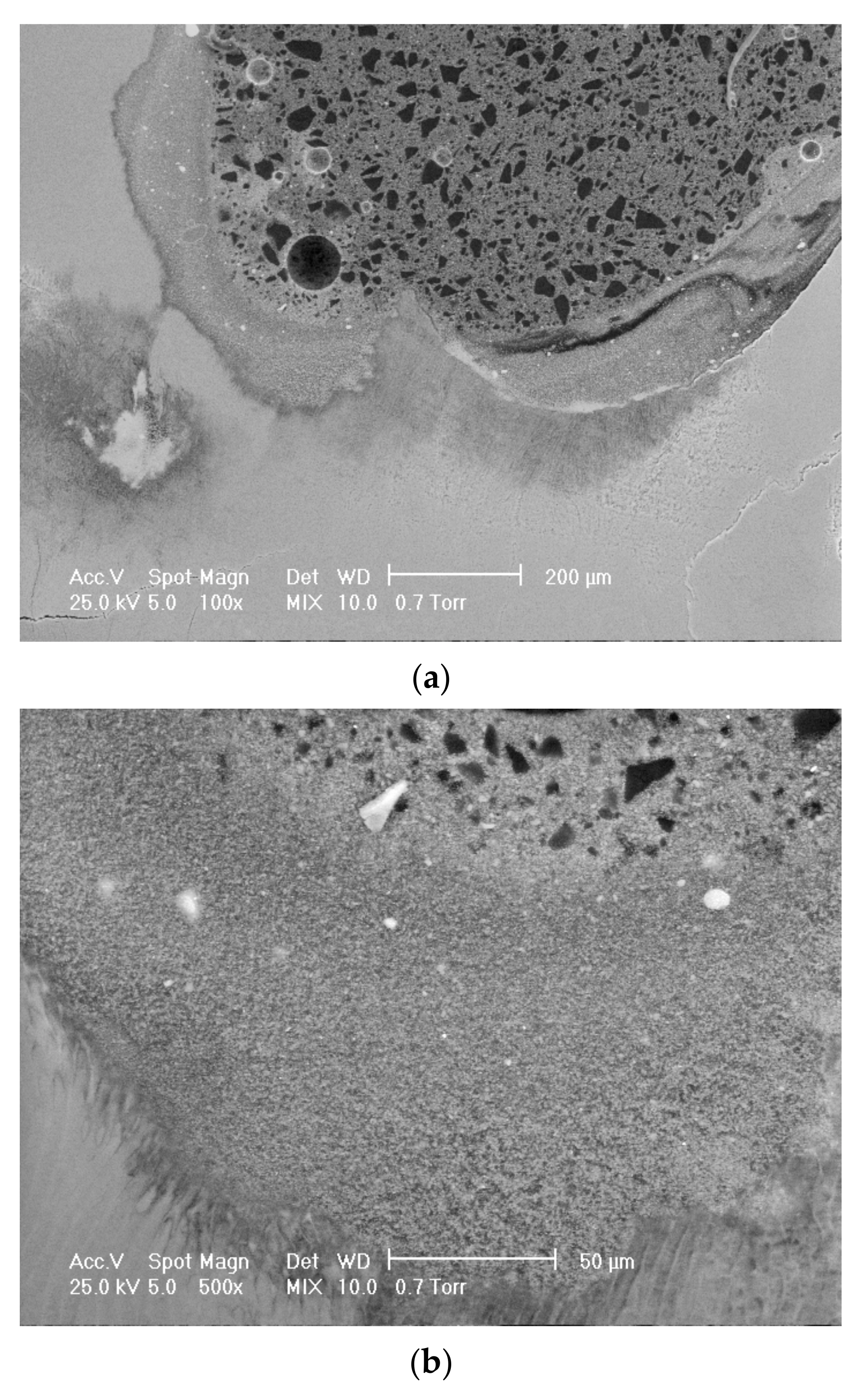
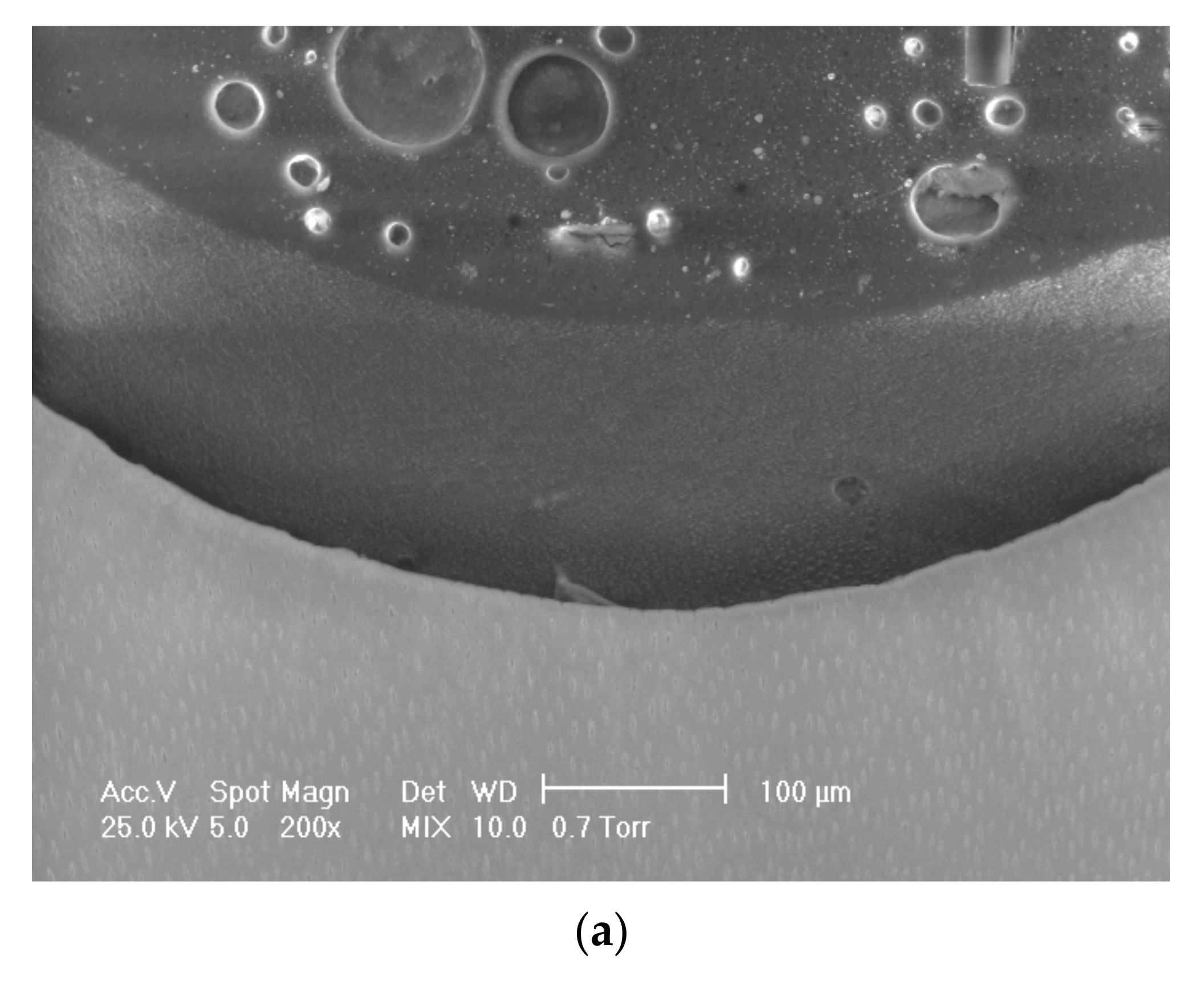
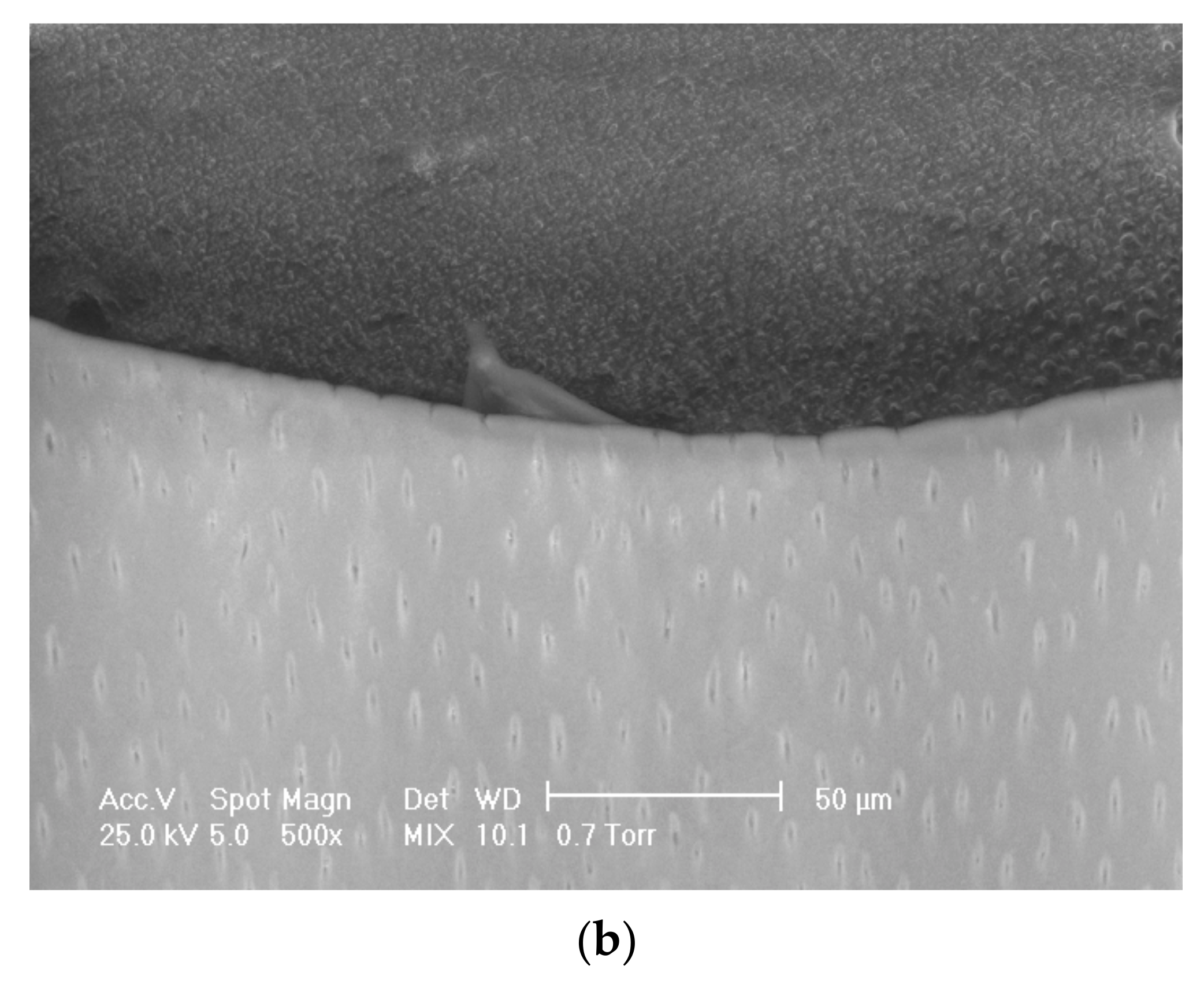


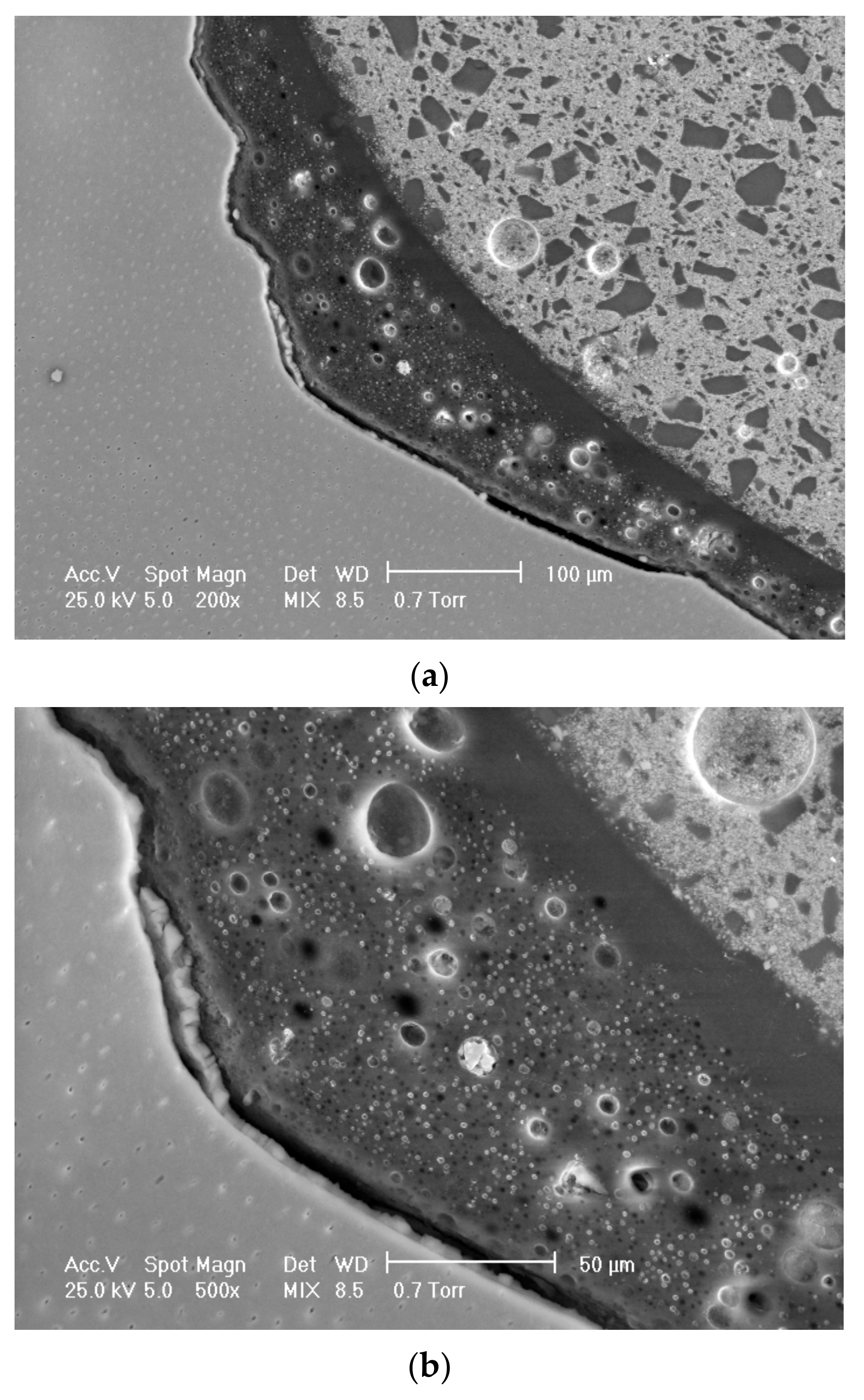
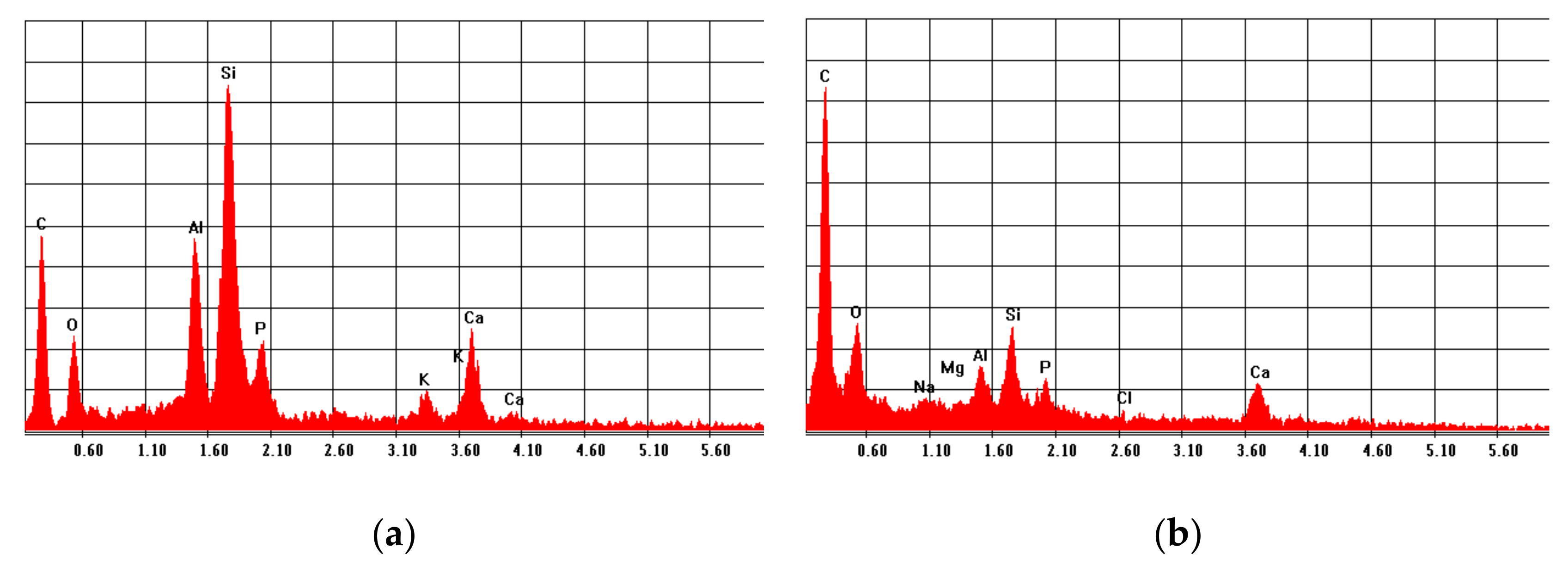

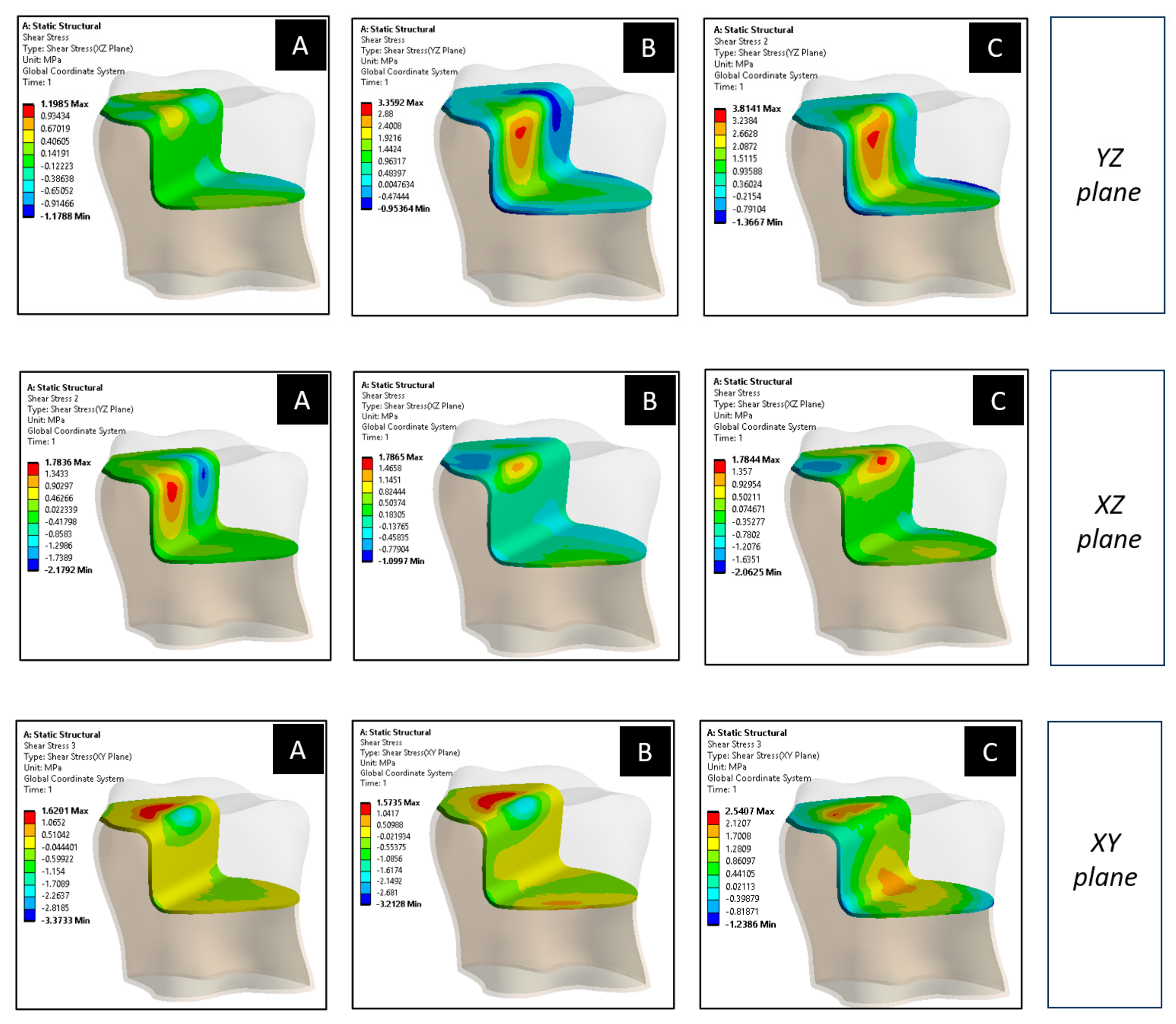
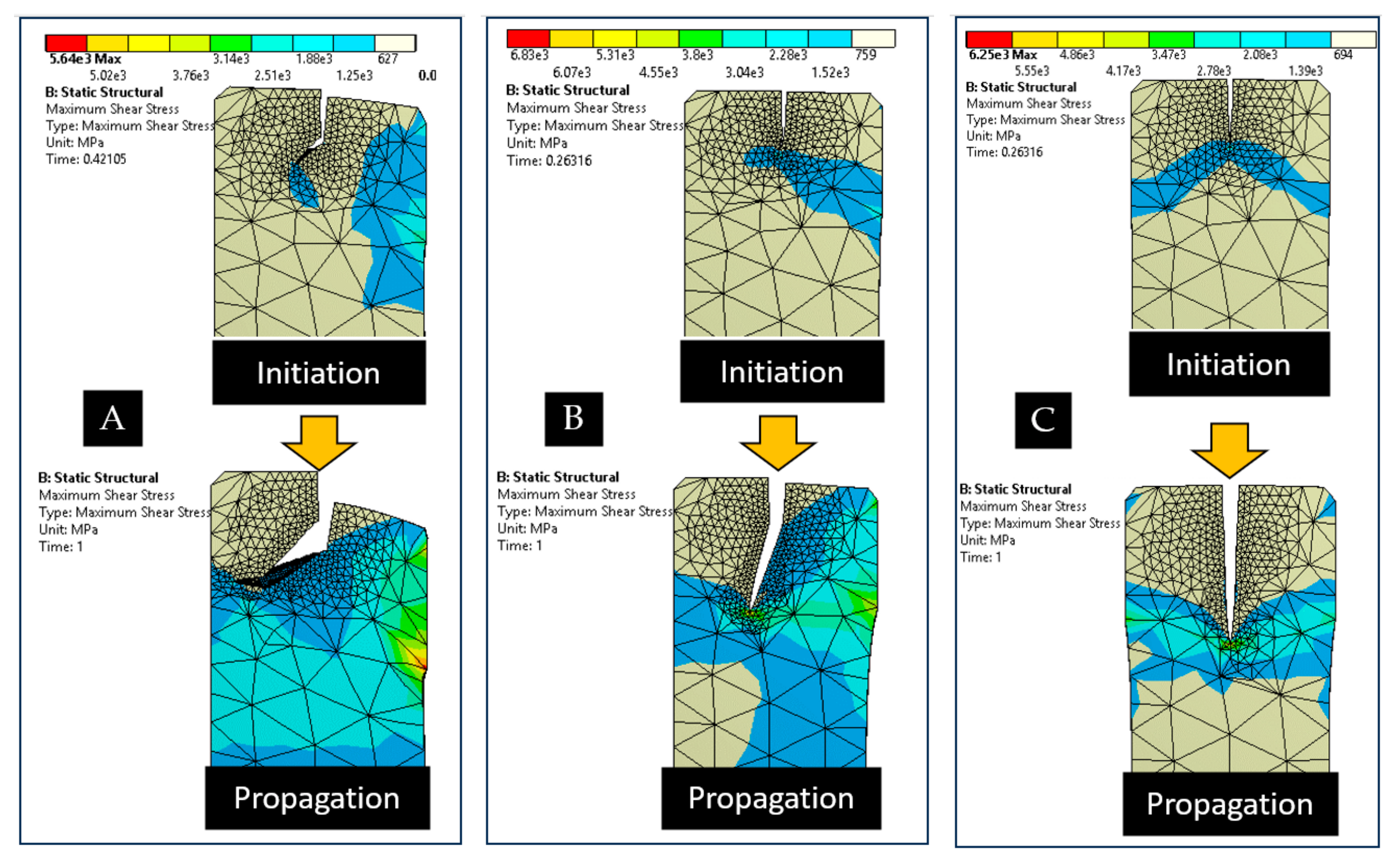
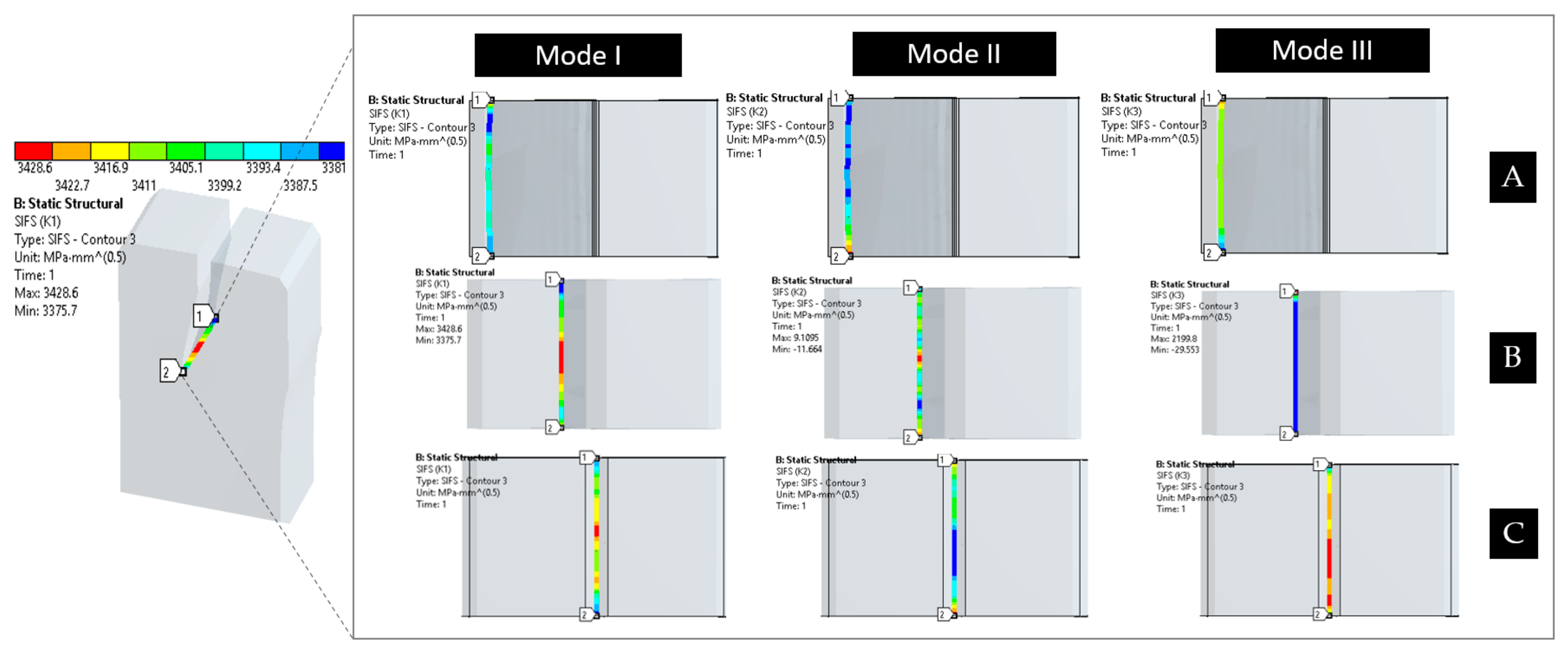
| Structure/Material | Density [kg/m3] | Young Modulus [GPa] | Poisson Ratio [-] | Fracture Toughness ] |
|---|---|---|---|---|
| Dentin | 2000 | 17.0 | 0.30 | - |
| Enamel | 2750 | 74.0 | 0.23 | - |
| Restoration material | 2480 | 8.0 | 0.34 | 0.38 |
| Universal adhesive | 2400 | 7.7 | 0.24 | 0.62 |
| Fourth-generation adhesive | 2400 | 8.1 | 0.25 | 1.52 |
| ] | |||||||
|---|---|---|---|---|---|---|---|
| A | max. | 30.46 | −0.69 | 11.68 | 8.80 | −0.15 | 4.69 |
| min. | 29.92 | −1.02 | −0.29 | 8.58 | −0.29 | −6.28 | |
| B | max. | 103.20 | 0.24 | 36.19 | 30.56 | 0.12 | 9.28 |
| min. | 102.59 | −0.58 | −0.90 | 29.67 | −0.43 | −9.89 | |
| C | max. | 95.53 | 0.34 | 1.45 | 28.11 | 0.12 | 0.63 |
| min. | 93.58 | −1.31 | −0.43 | 27.41 | −0.08 | −0.66 | |
Disclaimer/Publisher’s Note: The statements, opinions and data contained in all publications are solely those of the individual author(s) and contributor(s) and not of MDPI and/or the editor(s). MDPI and/or the editor(s) disclaim responsibility for any injury to people or property resulting from any ideas, methods, instructions or products referred to in the content. |
© 2023 by the authors. Licensee MDPI, Basel, Switzerland. This article is an open access article distributed under the terms and conditions of the Creative Commons Attribution (CC BY) license (https://creativecommons.org/licenses/by/4.0/).
Share and Cite
Călinoiu, Ș.G.; Bîcleșanu, C.; Florescu, A.; Stoia, D.I.; Dumitru, C.; Miculescu, M. Comparative Study on Interface Fracture of 4th Generation 3-Steps Adhesive and 7th Generation Universal Adhesive. Materials 2023, 16, 5834. https://doi.org/10.3390/ma16175834
Călinoiu ȘG, Bîcleșanu C, Florescu A, Stoia DI, Dumitru C, Miculescu M. Comparative Study on Interface Fracture of 4th Generation 3-Steps Adhesive and 7th Generation Universal Adhesive. Materials. 2023; 16(17):5834. https://doi.org/10.3390/ma16175834
Chicago/Turabian StyleCălinoiu, Ștefan George, Cornelia Bîcleșanu, Anamaria Florescu, Dan Ioan Stoia, Cătălin Dumitru, and Marian Miculescu. 2023. "Comparative Study on Interface Fracture of 4th Generation 3-Steps Adhesive and 7th Generation Universal Adhesive" Materials 16, no. 17: 5834. https://doi.org/10.3390/ma16175834
APA StyleCălinoiu, Ș. G., Bîcleșanu, C., Florescu, A., Stoia, D. I., Dumitru, C., & Miculescu, M. (2023). Comparative Study on Interface Fracture of 4th Generation 3-Steps Adhesive and 7th Generation Universal Adhesive. Materials, 16(17), 5834. https://doi.org/10.3390/ma16175834








